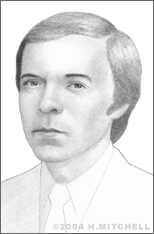Erno Rubik
One of the best-loved toys of all time, the Rubik’s Cube has puzzled and entertained people of all ages around the world. The device that became popular with the masses in the 1980s was created a decade earlier by Hungarian designer Erno Rubik. Born in Budapest in 1944, his father was an engineer and glider designer; his mother was a writer and artist. Rubik pursued sculpture for a time before studying and earning a degree in architecture in 1967. Shortly thereafter he became a teacher in the interior design department at the Academy of Applied Arts and Crafts in Budapest.
With his students, Rubik regularly used physical models and materials to teach concepts in construction and design. His interest in three-dimensional objects played a large part in his creation of the Rubik’s Cube. He had originally thought of putting a three-column cube together as a challenge to himself to see if he could find a way of moving individual parts without each of them losing their connection to the whole. The stumper was the interior structure of the cube. Rubik was reportedly inspired to use rounded elements for the center core of the cube one day in 1974 while he was noticing the smooth, polished, rounded stones by the banks of the Danube River.
Before long Rubik had completed a prototype with cylindrical parts connected to each cube component that gave the desired effect. (One can see his design today by taking a Rubik’s Cube apart.) Each of the faces of the cube would be one solid color at the start. With a few turns the colors would become mismatched. With 26 square components and 54 outer surfaces, the number of possible alignments is in the multi-millions. But there is only one “perfect” alignment. The game was an instant hit with Rubik’s students. He patented the device in 1975, calling it the “Magic Cube,” and brought it to the Hungarian toy marketplace in 1977.
It should be noted that at least two other inventors had patented similar cube designs around that time unbeknownst to Rubik, though theirs employed different mechanisms for holding the cubes together. Rubik’s cube was the one noticed in 1978 by Hungarian Tibor Laczi, who brought the device to the Nuremberg toy fair and had soon secured an order for one million of them from a British company, Ideal Toy. That’s when the name of the toy was changed to the “Rubik’s Cube,” and the West first became familiar with the puzzle.
A magazine cover featuring a picture of a Rubik’s Cube when mathematician Douglas Hotstadter wrote an article on it for Scientific America created the initial media buzz. By 1981 demand outgrew supply of the puzzles. More than 100 million of them had been sold around the world. Books offering solutions began hitting the shelves and there were even official Rubik’s Cube clubs and competitions. But by 1983 the fad cooled down, partially because of market saturation and pirated versions being sold in foreign countries. Eventually Ideal Toy sold its rights. The Rubik’s Cube enjoyed a brief resurgence in the early 1990s, marketed by the London-based company Seven Towns.
Today the Rubik’s Cube is still used as a teaching tool in fields such as physics and group theory, an area in abstract mathematics. In addition, its success is said to have helped Hungary along on its path to a free economy and its inventor continues to be seen as somewhat of a national hero. Rubik has used some of his income to help foundations supporting inventors in Hungary. He started a design cooperative known as the Rubik Studio, and he has produced several other games and puzzles. He continues to live and teach in Hungary.


